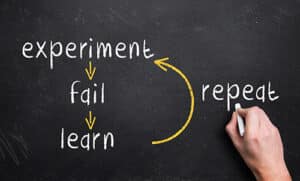
Designing a human-centric approach to performance management

As our team was first conceptualizing the design for what has now become, TQ Connect, it occurred to me that the worlds of software development and performance management were slowly beginning to overlap. Gone are the days of waterfall workflows where all requirements and outcomes are rigidly defined up front. Instead, we now live in an agile world where solutions are constantly evaluated based on user feedback in the context of an evolving business and cultural landscape.
Many of the human-centric principles that hold true for user experience design can also be applied to performance management. Instead of viewing your performance management process as a plan that is pushed down from above, it can instead be viewed as an iterative process, that is constantly evolving from the ground up based on employee input. Applying some basic user experience design principles can help you move towards a more agile, and human-centric approach, to performance management.

Think accessibly
At its core, accessibility is about reducing barriers to entry. In order to be successful, a performance management program needs to meet the employee on their terms. A good starting point is to integrate your performance management process into your employees’ daily routines. Can updates within your CRM feed into a goal’s progress? Can status updates and 1:1 meetings be recorded and set via email or calendar integrations? Are interactive and engaging learning experiences readily available to enhance developmental opportunities? Having regular touch points within the talent management lifecycle will ensure that performance management remains relevant for your employees as an easily accessible part of their daily workflow.

Keep it simple
Steve Krug’s book, Don’t Make Me Think, is a UX design classic about the need to avoid overwhelming a user with too much information and complexity at once. In the UX world, this is known as reducing cognitive burden. The same premise holds true in performance management. If feedback slowly builds over time it can become daunting to deliver and even more difficult to consume. Rather, feedback should be delivered in a timely fashion through regular check-ins. Your performance management process should provide an ongoing communication loop where the feedback recipient can easily prioritize bite-sized action items and also freely offer their thoughts on the process. Rather than viewing goal setting and performance management as complex, long-term initiatives that unfold over many months, instead break them down into smaller key results and action items that remain relevant on a daily or weekly basis.

Gather feedback and iterate
Just as agile software design processes respond to feedback from end users, so should your performance management program respond to feedback from employees. Avoid the temptation to “perfectly” plan your performance management process up front. Instead, it’s better to consider slowly evolving the process based on an analysis of real-world data. If you listen to your employees, from executives to individual contributors, they’ll tell you where things need to be adjusted to make the process more valuable and relevant. Conducting surveys is a great way to collect quantitative data, but it’s also important to regularly interview key stakeholders for a qualitative view of your performance management process.

Remove the fear of failure
For many, the fear of failure can be a big obstacle to overcome. However, human-centric design principles require a dramatic shift in our mindset regarding failure and vulnerability. It’s only through accepting and analyzing feedback that we are able to iterate and improve. This can be daunting when considering the implications of democratizing elements of a performance management process, but always consider that the end goal is to make the process more valuable for your employees and, ultimately, your organization. Finding out what doesn’t work is just as important as verifying what is working. Human-centric design requires an openness to being imperfect.
Rather than providing a detailed roadmap for developing a human-centric performance management program, these principles are intended to get you started in the right direction. Each organization is unique and there is no one-size-fits-all approach. However, the first step always involves a mindset shift, moving away from a top-down philosophy and instead placing your employees at the center of the process.
